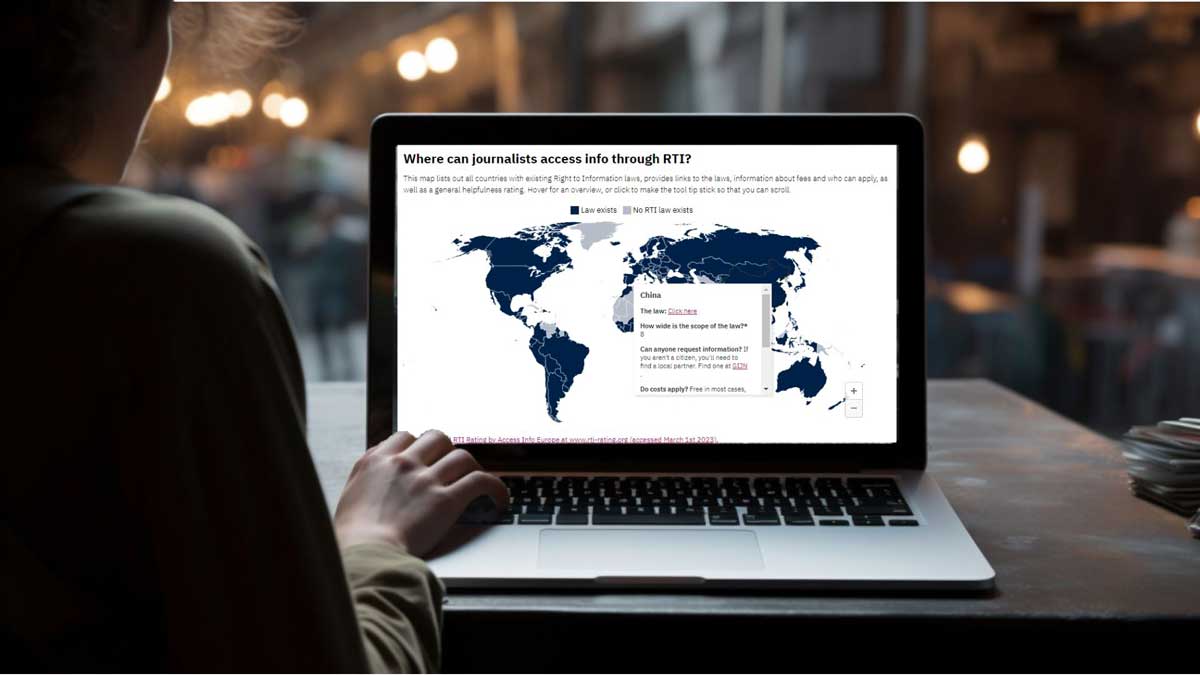Bypassing secrecy: New tools to facilitate more cross-border investigations with RTI

View of the shoulder of a journalist using Tarjei's RTI map. Credit: Midjourney
In this piece
What is RTI? | Leverage the disparities: an interactive map | How to use RTI | Beyond RTIIn the opening pages of A Hitchhiker’s Guide to the Galaxy, fictional character Arthur Dent wakes up one morning to find that Earth will be destroyed to make way for a new intergalactic highway. The alien construction workers explain the inconvenience might have been avoided if we had submitted an Intergalactic Right to Information (RTI) request and filed an appeal ahead of the deadline.
We currently lack such cosmic laws. But on our planet, at least, 136 countries have embraced RTI – opening doors for international collaboration in journalism.
What is RTI?
RTI is a powerful journalistic tool that empowers citizens to access public documents and fosters transparent governance. The concept dates back to 1766 when Finnish priest Anders Chydenius first intertwined free speech with the right to access public information. More than 200 years later, RTI laws vary across nations, but all have the potential to serve as vital instruments for investigative journalism.
These investigations can be particularly powerful when they leverage collaboration between journalists from different nations. We saw the results of this in the Panama Papers and similar exposés that revealed how the financial sector was exploiting legal loopholes to conceal financial activities.
Leverage the disparities: an interactive map
What would happen if journalists did the same thing as the banks? By capitalising on disparities between countries' RTIs, we could emulate the financial sector's tactics to unravel stories that span borders.
Some journalists are already doing this, and with great success. I have interviewed participants from four very different cross-border investigation teams on their experiences with using RTI across borders and what they achieved and learnt in the process. (See full PDF for interviews.)
With this in mind, I have made an interactive map.
I hope this map will give journalists visual insights into the global landscape of RTI laws. Wherever an RTI law exists, I have included the Centre for Law and Democracy’s Global RTI Rating and a link to an English translation of the law. There is also information about whether anyone can request information, or if you need help, you can use a tool like the members list of Global Investigative Journalism Network to find a journalist you can partner with.
Finally, the map outlines whether you should expect to encounter fees, and if you are required to provide a reason for your request.
Note for visually impaired readers: Full data set used to build the interactive map above can be downloaded in table form here.
How to use RTI
The journey of a journalist pursuing an RTI request is a nuanced one. A writer navigates bureaucratic intricacies, seeking essential documents within vast archives. Online tools like as WhatDoTheyKnow (UK), FragDenStaat (Germany), eInnsyn (Norway), Muckrock (U.S.) or AskTheEU (EU bodies) streamline the process, forwarding requests to the appropriate authorities while recording interactions for future reference. Such platforms, crucial in cross-border collaborations, foster knowledge exchange and access to shared documents.
While online portals aid efficiency, some journalists opt for direct engagement to minimise digital traces. Portals like FragDenStaat and AskTheEU offer features to safeguard information requests until publication, protecting journalistic endeavours from premature exposure.
Beyond RTI
International conventions, like the Aarhus Convention, extend the information request toolkit beyond the public sector. Enacted in 1998, it grants rights to environmental information, participation in environmental decisions, and environmental justice. Ratified by 38 UN member countries, including the EU, it opens avenues for investigative journalism spanning both public and private domains.
Note for visually impaired readers: Full data set used to build the interactive map above can be downloaded in table form here.
Another potent tool in the journalist's arsenal is the General Data Protection Regulation (GDPR). Launched in 2018, it transformed digital privacy and data control. Journalists who are informed about GDPR's Subject Access Requests (SARs) can empower sources to demand information storage transparency. This synergy uncovers concealed truths, from private corporations to religious sects.
In a world with growing interconnectedness, 136 countries embrace RTI laws, while cross-border collaborations can broaden access.
I hope these tools will enrich your journalistic arsenals, offering pathways into public and private realms. I hope they also inspire exciting new cross-border collaborations. If you want even more inspiration, see the full PDF below, which includes details from four real-life case studies of journalists who collaborated on cross-border RTI, including Wasteland (Investigate Europe), Tierra de Resistentes (Consejo de Redaccion), Inside the Suspicion Machines (Lighthouse Reports), and The Frontex Files (Open Knowledge Foundation).
These great examples show how journalists can combine legal avenues and skill sets to illuminate diverse facets of complex stories to foster greater societal understanding.




